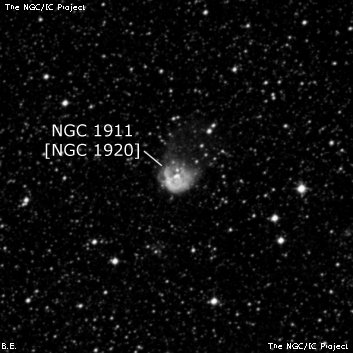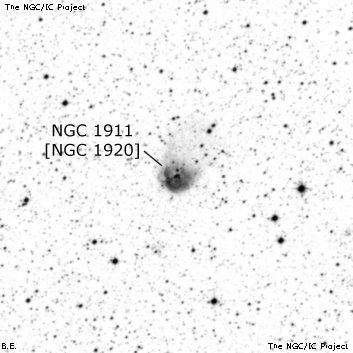NGC/IC Project Restoration Effort
(This is a very very beta version)
NGC1915


Basic Information
Location and Magnitude
Right Ascension: 5:19:42.3
Declination: -66:49:17
Constellation: DOR
Visual Magnitude:
Historic Information
Discoverer: Herschel J.
Year of discovery: 1837
Discovery aperture: 18.3
Observational
Summary description: eF, pL
Sub-type: NF
Corwin's Notes
=====
NGC 1915. JH has this in only one sweep (760 on 2 Jan 1837), and calls it
only "eF, pL." However, he adds (parentheses are his), "(Possibly the same
with No. 2826 [NGC 1911], but the nebulae are so crowded that they may with
equal probablility be different ones.)" I don't think it is the same as N1911
(which see). The descriptions are too different, and N1911 is probably the
same object as N1920.
So, what then is N1915? JH's position is about an arcminute northwest of the
center of a stellar association 3 arcmin by 2 arcmin across (coincidentally,
there is a faint cluster on the northeastern edge of the association). The
object shows up clearly on the Southern Sky Survey IIIa-J film, somewhat less
clearly on the 2nd generation DSS image, and not at all on the quick V plate
used for the DSS distributed on CD-ROM. The association is, admittedly,
pretty faint to have been picked up visually. Still, JH was careful, had keen
eyesight, and didn't miss much in the LMC that he could have seen.
Another possibility is that N1915 is a second observation (in the following
sweep on the next night, 3 Jan 1837) of NGC 1919 which JH also describes as
"eF, L ...". He goes on to add, however, "... irreg R, 4 [arcmin] diam.
Resolved into small stars with nebulous light." That is a perfect description
of NGC 1919, a cluster immersed in a reflection nebula. Is it possible that
JH missed the stars the first time around?
Finally, as with NGC 1911 (which see), Archinal and Hynes have an entry for
this cluster, equating it with KMHK 761. As with NGC 1911, KMHK 761 is much
too faint to be JH's object. Again, Jenni Kay concurs.
In February of 2014, Steve Gottlieb sent his own observation of NGC 1915 with
a 24-inch reflector at Magellan Observatory in Australia: "[This is a] fairly
small knot of four mag 14-14.5 stars with perhaps some unresolved haze, ~40
arcsec diameter. Appears to be an asterism only and unimpressive. Three mag
11-12 stars lie 2'-3' E and emission nebula NGC 1920 is 6' ENE." He adds the
comment, "... when I looked at this region in November 2012, the only object I
noted was a group of 4 stars near [JH's] position, but I would think these
would have been resolved by Herschel." Looking at the DSS2R, I would agree,
but since the stars are close to JH's position, I've included them as another
candidate for NGC 1915. Jenni Kay has also taken this asterism as NGC 1915,
and makes it NGC 1911 (which see) as well, though I think that is actually
NGC 1920.
-----
The sweep itself confirms JH's note that the nebulae are crowded. This object
came just a minute and five seconds after the preceding object (NGC 1905) and
fifty seconds before the next (NGC 1920). All three were taken as they left
the field, and all three are correctly reduced.
If JH made a wire recording error, the actual RAs for 1830 would be 05 22 09,
and 05 20 47 for wires 1 and 2 respectively. Precessing to J2000 shows empty
fields, though NGC 1920 is near the position implied by wire 2. However, JH
saw that in the same sweep.
So, the mystery about NGC 1915 remains.
Steve's Notes
=====
NGC 1915
24" (11/18/12 - Magellan Observatory, Australia): fairly small knot of four mag 14-14.5 stars with perhaps some unresolved haze, ~40" diameter. Appears to be an asterism only and unimpressive. Three mag 11-12 stars lie 2'-3' E and emission nebula NGC 1920 is 6' ENE.
This identification of NGC 1915 is very uncertain and this number may refer instead to open cluster ESO 085-SC71 located 4' N. It also may be a duplicate observation of either NGC 1919 or 1920.



